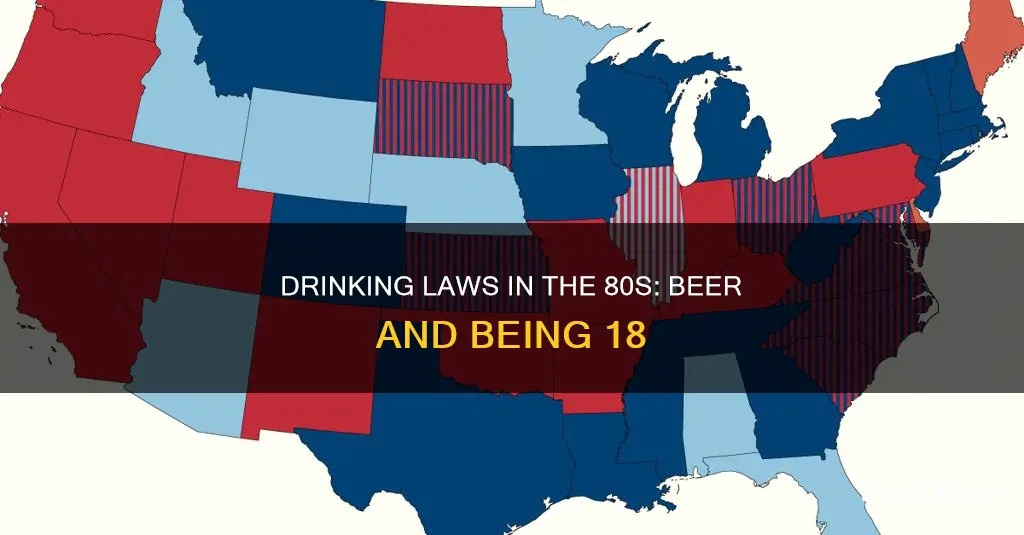
In the 1980s, the drinking age in the United States was 18, but in 1984, President Reagan passed a bill that raised the drinking age to 21. This meant that from 1984 onwards, 18-year-olds could no longer drink beer legally. However, this change in law did not stop underage drinking, and many young people continued to drink alcohol, with some even reporting drinking from as young as 11. The ease of access to alcohol for underage drinkers was due to a variety of factors, including lax carding practices in bars, the ability to create fake IDs, and the willingness of older friends and strangers to purchase alcohol for minors.
| Characteristics | Values |
|---|---|
| Drinking age in the 80s | 18 |
| Current drinking age | 21 |
| Reason for the change | Reagan passed a bill in 1984 that required states to raise their drinking age to 21 |
| Exception | Some states allow exceptions for religious activities or consent by a parent, spouse or guardian in specific locations. |
What You'll Learn
- In the 80s, the drinking age was raised from 18 to 21
- The 21st Amendment to the Constitution allows each state to make their own laws regarding the sale and distribution of alcohol
- In the 70s and 80s, it was easy to get alcohol underage
- Underage drinking is a serious public health concern
- The National Minimum Drinking Age Act was passed in 1984

In the 80s, the drinking age was raised from 18 to 21
In the 1980s, the drinking age in the United States was raised from 18 to 21. This change was the result of a bill passed by President Reagan in 1984, which required states to raise their drinking age to 21 or lose 10% of their federal highway funding. By 1988, all 50 states and the District of Columbia had complied with the new law.
The push to raise the drinking age was driven in part by organisations like Mothers Against Drunk Driving (MADD), who wanted to reduce the number of drunk driving fatalities. According to MADD, the higher drinking age has saved 17,000 lives on the highways since 1988. However, some people feel that MADD has gone too far, and there have been several efforts to bring the drinking age back down to 18.
The change in the law had a significant impact on young people's drinking habits. Those who were already 18 when the law was passed found themselves in the unusual position of being legally able to buy alcohol one day and not the next. This led to a period of confusion, with some people being allowed to drink due to 'grandfather clauses' in the new law.
Prior to the 1980s, the legal drinking age in the US had been a bumpy ride. After Prohibition ended in 1933, the drinking age was set at 21. However, during the Vietnam War, the drinking age was lowered to 18. In the early 1970s, the voting age was lowered from 21 to 18, and many states followed suit by lowering the drinking age as well. By the mid-1970s, some 30 states had a drinking age of 18.
However, concerns about drunk driving began to mount, and from 1976 to 1983, several states voluntarily raised their drinking ages to 19, 20, or 21. The passage of the National Minimum Drinking Age Act in 1984 put an end to the variability, establishing 21 as the uniform legal drinking age across the country.
Metformin and Beer: Is It Safe to Drink Alcohol?
You may want to see also

The 21st Amendment to the Constitution allows each state to make their own laws regarding the sale and distribution of alcohol
The 21st Amendment to the US Constitution, passed in 1933, repealed the 18th Amendment, which had banned the production, transport, and sale of alcohol. The 21st Amendment also established the power of individual states to regulate the importation, distribution, and sale of alcohol within their borders. This amendment gives states the authority to set their own laws regarding alcohol, including the minimum age for purchase and consumption.
The 21st Amendment allows states to regulate alcohol in ways that may be inconsistent with other provisions of the Constitution. For example, in the case of State Board of Equalization v Youn (1936), the Supreme Court upheld a California law that imposed a $500 fee on the importation of beer into the state, which discriminated against out-of-state commerce. This decision recognised the state's power to regulate alcohol under the 21st Amendment.
The drinking age in the US has changed over time. In colonial America, there were generally no age restrictions on alcohol purchase, and consumption by young teenagers was common. After the American Revolution, religious sentiments and growing medical concerns about alcohol led to more restrictions. Following the repeal of Prohibition in 1933, most states set the drinking age at 21, as this was the voting age at the time.
From 1969 to 1976, about 30 states lowered their drinking ages, often in response to the lowering of the voting age to 18 in 1971. By the early 1980s, several states began to raise their drinking ages again, primarily to combat drunk driving fatalities. In 1984, the National Minimum Drinking Age Act was passed, requiring states to set the drinking age at 21 or lose a portion of their federal highway funding. By 1988, all 50 states had raised their drinking ages to 21.
While the 21st Amendment gives states the power to regulate alcohol, there are still federal laws and policies that impact alcohol-related issues. Federal policy, including the National Minimum Drinking Age Act, sets the minimum age for alcohol-related activities such as drinking, purchasing, and serving. Additionally, the federal government defines an alcoholic beverage as any beverage containing over 0.05% alcohol, and most states honour this limit.
Drinking Beer While Taking Cardizem and Ceftin: What's the Verdict?
You may want to see also

In the 70s and 80s, it was easy to get alcohol underage
In the 1970s and 1980s, the legal drinking age in the United States was 18 in many states. In the 1970s, the voting age was lowered from 21 to 18, and many states followed suit by lowering the drinking age as well. This meant that in the 1970s and early 1980s, it was relatively easy for underage individuals to purchase alcohol.
During this time, there were minimal restrictions on alcohol sales, and many bars and liquor stores did not card their customers. It was common for underage individuals to use fake IDs or to have older friends or siblings purchase alcohol for them. In some cases, underage individuals were even served alcohol in bars and restaurants without being asked for identification.
Additionally, social norms around alcohol consumption were different in the 1970s and 1980s. There was less stigma around underage drinking, and it was often seen as a rite of passage for teenagers and young adults. As a result, there was less enforcement of drinking laws, and underage individuals could more easily access alcohol without facing legal consequences.
However, it's important to note that this ease of access to alcohol also led to concerns about drunk driving and other negative consequences. Starting in the late 1970s and early 1980s, some states began to voluntarily raise the drinking age to combat these issues. In 1984, the National Minimum Drinking Age Act was passed, which required all states to raise the drinking age to 21 by 1986 or lose a portion of their federal highway funding. As a result, the legal drinking age is now 21 nationwide.
Beer, Guns, and Georgia Laws: What's Allowed?
You may want to see also

Underage drinking is a serious public health concern
In the 1980s, the legal drinking age in the United States was 18. However, in 1984, President Reagan passed a bill that raised the minimum drinking age to 21. This change was motivated by concerns about the dangers of underage drinking, including drunk driving fatalities. While some states initially resisted the change, by 1988, all 50 states had adopted the higher drinking age.
Underage drinking continues to be a significant public health issue in the United States. Despite the legal drinking age, approximately 11% of all alcohol consumed in the country is by individuals between the ages of 12 and 20. Underage drinking increases the risk of accidents, crime victimisation, injuries, and addiction. According to the National Institute on Alcohol Abuse and Alcoholism, 60% of youth admit to drinking at least once by the time they turn 18.
The consequences of underage drinking can be severe and long-lasting. Alcohol interferes with brain development and can lead to immediate hazards as well as potential long-term damage. It disrupts normal thinking, decision-making, and memory functions, posing risks not only to the drinker but also to those around them.
To address these concerns, states have implemented various exceptions and regulations regarding underage drinking. For example, some states allow minors to consume alcohol for educational, religious, or medical reasons, with parental consent, or for law enforcement purposes. However, social host laws hold individuals responsible for underage drinking events on their property, even if they did not provide the alcohol.
While the minimum drinking age aims to curb underage drinking, the effectiveness of this measure is debated. Some argue that it has driven underage drinking underground, leading to more dangerous and clandestine behaviour. Others point to the decline in alcohol-related deaths and fatalities since the implementation of the higher drinking age.
Beer Drinking Censorship in Commercials: Why the Ban?
You may want to see also

The National Minimum Drinking Age Act was passed in 1984
The Act required states to set their minimum purchasing age to 21 or face a 10% reduction in their federal highway funding. This financial penalty gave states a strong incentive to change the drinking age, and by 1995, all 50 states, two permanently inhabited territories, and Washington, D.C., had complied. However, Puerto Rico, the Virgin Islands, and Guam chose to maintain a drinking age of 18, despite the loss of federal funding.
The National Minimum Drinking Age Act did not outlaw the consumption of alcohol by those under 21; it only prohibited the purchase or public possession of alcoholic beverages by minors. Despite this, some states, such as Alabama, Arkansas, Idaho, New Hampshire, and West Virginia, extended the law to implement an outright ban on underage drinking.
The Act was a response to the increasing number of motor vehicle fatalities attributed to the decrease in the minimum legal drinking age during the 1970s. Between 1970 and 1975, 29 states lowered the minimum drinking age from 21 to 18, 19, or 20, primarily due to the passing of the Twenty-sixth Amendment, which lowered the voting age from 21 to 18. However, studies soon showed a significant increase in road deaths linked to the lower drinking age. As a result, the National Minimum Drinking Age Act was passed to standardize the drinking age across the country and reduce alcohol-related road fatalities.
The Act has been subject to debate, with some arguing that it has driven underage drinking underground and contributed to a culture of binge drinking on college campuses. Others have questioned the effectiveness of the law, noting that other factors, such as improved highway design, vehicle safety, and increased seat belt use, have also contributed to the decline in alcohol-related road deaths. Despite this, organizations like MADD and the American Medical Association continue to support upholding the 21 minimum age limit, citing the Act's impact on reducing drunk driving fatalities.
Drinking Beer on Myrtle Beach: What You Need to Know
You may want to see also
Frequently asked questions
Yes, the drinking age was 18 in the 80s until 1984 when President Reagan passed a bill that raised the drinking age to 21.
Yes, beer was a popular alcoholic drink in the 80s.
Yes, people drank other alcoholic drinks like wine, vodka, gin, cocktails, and liquor.
Yes, it was easy to get alcohol underage in the 80s. People had fake IDs, bought alcohol from stores that didn't check IDs, and got older friends or family members to buy alcohol for them.
Some popular alcoholic drinks in the 80s include Cold Duck Wine Coolers, Bartle's and James, Coors, Budweiser, and Miller Lite.







